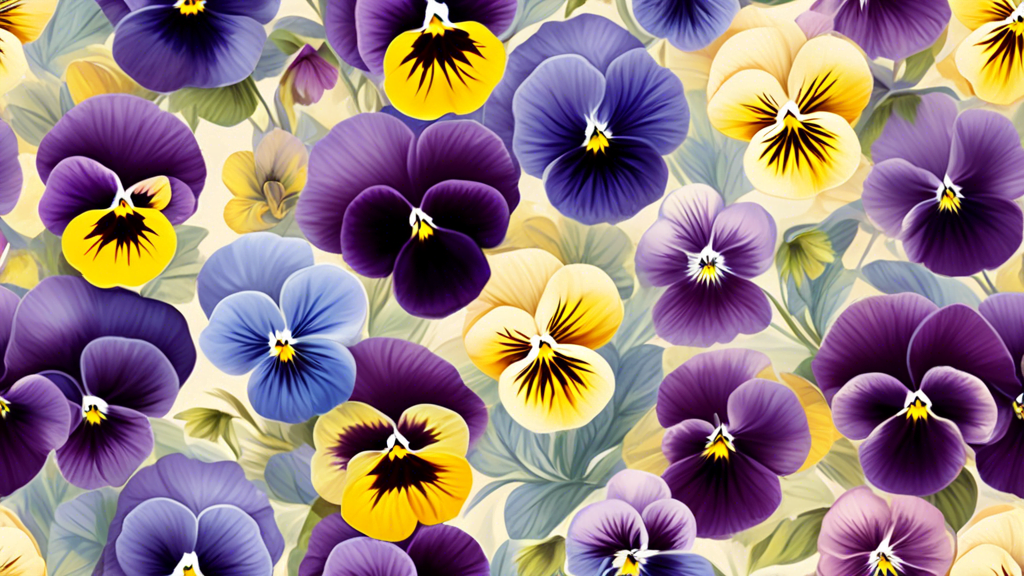The Symbolism of Pansies: What These Flowers Represent
Pansies have captivated gardeners and flower enthusiasts with their vibrant colors and delicate petals for centuries. These charming flowers carry a wealth of symbolism and meaning that has evolved over time. Let’s explore the rich history and symbolic significance of pansies.
The Enchanting History of Pansies
Wildflower Beginnings
The pansy’s story starts with its wild ancestor, the heartsease (Viola tricolor). These small, three-colored wildflowers were found throughout Europe and western Asia. Their unique heart-shaped markings caught people’s attention.
Medieval Metamorphosis
During the Middle Ages, pansies found their way into European gardens. Monks cultivated them for medicinal purposes. However, due to its heart shapes and dual colors, people began associating the flower with romantic love and faithfulness.
Selective Breeding Takes Root
The 16th century saw a surge in interest in selective breeding. Gardeners began experimenting with heartsease, aiming for larger flowers with a wider range of colors. Over time, their efforts yielded the pansy we know today.
Victorian Symbolism
By the Victorian era, pansies had become a mainstay in European gardens. The Victorians assigned new meanings to the pansy based on color:
- Blue: Thoughtfulness
- White: Innocence
- Purple: Passionate love
20th Century and Beyond
The 20th century saw further hybridization, resulting in the incredible variety of pansy colors and patterns we enjoy today. Pansies also gained popularity in North America, symbolizing spring and resilience.
Pansies Symbolism Across Cultures
Pansies have been ascribed to different meanings in various cultures and contexts, often reflecting their complex and multifaceted nature.
Europe
- Love and Thoughtfulness: In Victorian Europe, pansy colors held specific meanings. Blue symbolized thoughtfulness, white purity and innocence, and purple passionate love. This romantic association likely stemmed from the flower’s heart-shaped markings.
Greece
- Remembrance: In Greek mythology, pansies were associated with Persephone, the goddess of spring and the underworld. Here, they symbolized remembrance and mourning, a stark contrast to the love-related meanings in Europe.
France
- Freethinking: The French word for pansy is “pensée,” which translates to “thought.” In 16th-century France, pansies were linked to freethinkers and intellectuals, representing contemplation and deep thought.
Germany
- Faithfulness: Germans associated pansies with Treue (faithfulness) due to their heart shape and the fact that they often bloom in pairs. This symbolism aligned with the concept of everlasting love.
China
- Humility: In Chinese culture, pansies represent humility. This meaning might be linked to the flower’s delicate nature and tendency to droop its head slightly.
Pansies’ symbolism is multifaceted. While love and thoughtfulness are common themes, their meaning can vary depending on the culture and historical context.
The heart shape often plays a role, symbolizing emotions and remembrance. Interestingly, their color variations offer an extra layer of meaning, making them versatile messengers in the language of flowers.
Thoughtfulness and Remembrance
The pansy’s linguistic roots and historical uses underscore its association with thoughtfulness. Giving pansies conveys a message of deep consideration and remembrance.
They serve as a gentle reminder to think about loved ones, either in times of celebration or as a tribute.
Love in Idleness
Rooted in Shakespearean lore, pansies are often associated with love in idleness. This notion traces back to Shakespeare’s play A Midsummer Night’s Dream, where a love potion is created from a pansy.
According to the tale, the flower’s juice, when placed on someone’s eyelids while they sleep, would cause them to fall in love upon waking.
Other Cultural Interpretations
| Culture | Symbolic Meaning |
|---|---|
| Greece | Remembrance and mourning, associated with the goddess Persephone |
| France | Freethinking and deep thought, linked to the word “pensée” meaning “thought” |
| Germany | Faithfulness, due to their heart shape and tendency to bloom in pairs |
| China | Humility, representing the flower’s delicate nature |
As you can see, pansies hold diverse symbolic meanings across cultures, often tied to their distinctive appearance and linguistic origins.
Thoughtful Reflection
Given their name’s derivation from the word “thought,” pansies are often symbolic of contemplative introspection.
They remind one to consider one’s decisions and reflect thoughtfully on life’s events. This symbolism encourages mindfulness and the careful evaluation of one’s actions.
Spiritual Guidance
In more esoteric traditions, pansies are considered symbols of spiritual insight and guidance.
Their three prominent petals have been interpreted as representing the Holy Trinity in Christianity, making this flower a motif for divine guidance and blessings.
Pansies Symbolism in Colors
The symbolism of pansies can also vary depending on their color:
- Purple Pansies: Often associated with nobility, beauty, and royalty, purple pansies convey a sense of pride and admiration.
- Yellow Pansies: Represent joy, happiness, and positivity. They are perfect for celebrating special occasions and spreading cheer.
- Blue Pansies: Symbolize serenity, peace, and calm. They are often used to convey a sense of tranquility and spiritual well-being.
- Red Pansies: Though less common, red pansies can symbolize deep love, passion, and respect.
- White Pansies: Represent purity, innocence, and unity, making them suitable for weddings and other symbolic ceremonies.
Pansies in Art and Literature
Pansies have captured the imaginations of artists and writers, featuring prominently in various works of literature and visual art.
From Shakespeare’s plays to the intricate floral still-life paintings of the Victorian era, pansies are celebrated for their beauty and symbolic richness.
Conclusion
The symbolism of pansies is both rich and varied, encompassing notions of remembrance, love, thoughtfulness, and spiritual guidance.
Over centuries, these flowers have become more than mere decorative elements; they are emblematic carriers of profound and multi-layered meanings.
Whether used to express the depth of one’s emotions, celebrate life’s special moments, or find peace in times of reflection, the pansy is a powerful symbol.
FAQ
What is the folklore of pansies?
Folklore associated pansies with various things. In some cultures, they were seen as emblems of remembrance for the dead, while others believed they held magical properties for love potions. Overall, pansies were often linked to emotions and thoughts.
What is special about pansies?
Pansies are special for a few reasons. Their vibrant colors and velvety texture make them visually captivating. They’re also known for their resilience, blooming well into cooler weather. Perhaps most special is their symbolic meaning, which can be interpreted in many ways.
Do pansies mean friendship?
Pansies can symbolize friendship, particularly yellow or purple varieties. Yellow is often associated with joy and camaraderie, while purple can represent loyalty and trust, both important aspects of friendship.
What did pansies represent in the Renaissance?
During the Renaissance, pansies were linked to freethinking and intellectual pursuits. This association likely stemmed from the French word for pansy, “pensée,” which translates to “thought.”
What do the pansies symbolize in Hamlet?
In Shakespeare’s Hamlet, Ophelia distributes flowers, including pansies. Pansies were associated with remembrance and innocence, which could reflect Ophelia’s mental state or foreshadow her tragic demise.







